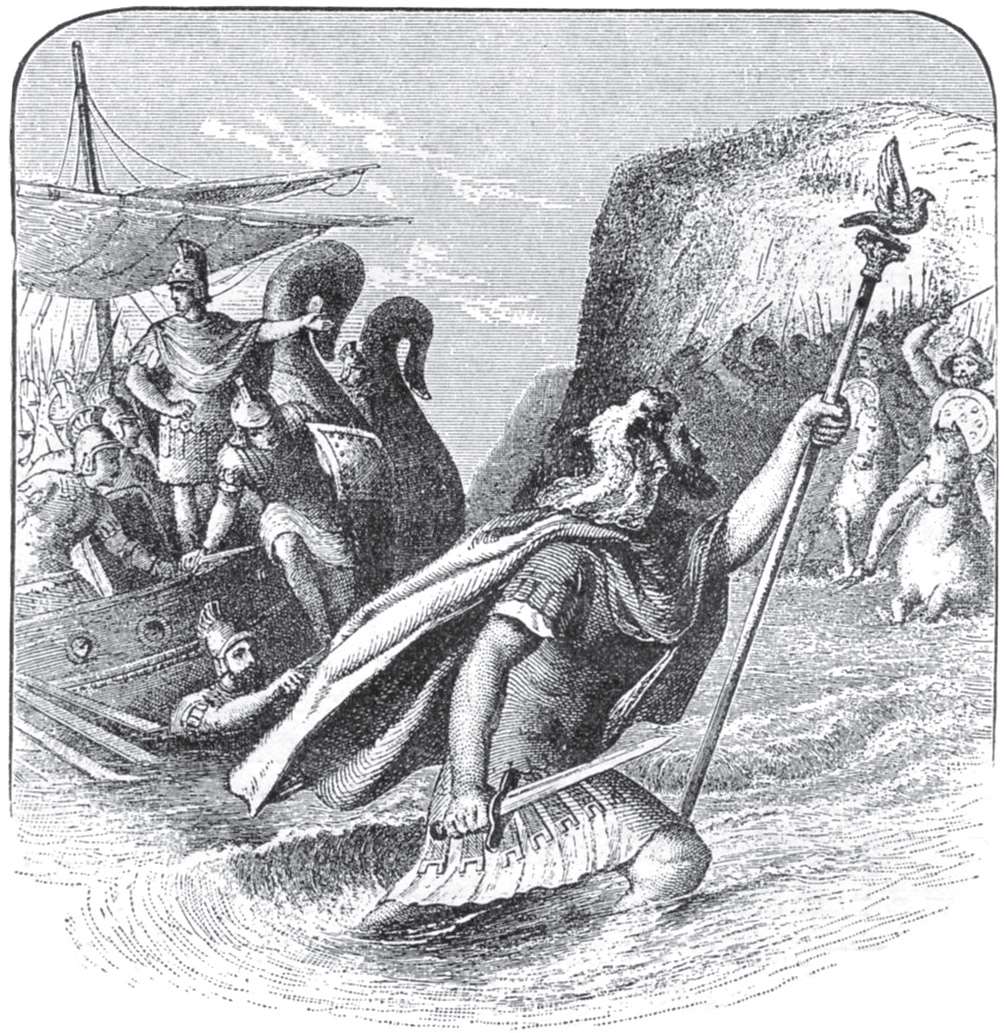





expelled, driven out. principal, chief.
galleys, vessels moved forward by sails and oars. sack, storming; plundering.
skyline, line made by the meeting of the sky and the sea. legions, armies.
standard, banner or a flag-staff. oppose, prevent.
1. Fifty-five years before the birth of Christ, Julius Caesar, a great Roman general, landed in Britain with a number of men. On an August morning, some Britons looking out to sea from the top of the chalk cliffs on the south coast,saw a number of dark specks on the sky-line. They were Caesar's ships—galleys rowed by very many oars.
2. When the Britons saw that the ships were filled with armed men, they gathered in great numbers on the shore to oppose their landing. At first the Romans were afraid to leap into the sea and to fight with the Britons, of whom they had heard terrible tales. But an officer, seizing the Roman standa—the image of an eagle—jumped into the water, calling out, “Follow me!”

THE LANDING OF THE ROMANS.
3. Then the Romans swarmed on shore in great numbers, and a terrible battle was fought, in which the Britons were defeated. Having forced the Britons to pay him tribute-money, Caesar went back to France (then called Gaul); but he returned to Britain next year, and seized on the south coast. This was the beginning of the Roman Times in British history. They lasted four hundred and sixty-five years.
4. It was not until nearly one hundred years after this that the Romans gained any sure footing in Britain. In the time of the Emperor Claudius they came in great numbers and made themselves masters of a large part of the country. A brave British chief, named Caradoc or Caractacus
 was defeated and taken prisoner; and the Druids were expelled from Mona (Anglesey).
was defeated and taken prisoner; and the Druids were expelled from Mona (Anglesey).
5. Agricola was the chief Roman governor of Britain. He held power during seven years; and, having invaded Caledonia (Scotland), he defeated a chief named Galgacus in a great battle.
6. The Romans built several walls across Britain, to protect themselves from the attacks of the Picts or Caledonians. The principal of these were the Wall of Hadrian,
 from the Tyne to the Solway Firth; and the Wall of Antonine,
from the Tyne to the Solway Firth; and the Wall of Antonine,
 from the Forth to the Clyde.
from the Forth to the Clyde.
7. The Sack of London by the Picts and the Scots,
 in 369 A. D., is a clear sign that the Roman power was decaying in the island. Finally, in 410 A. D., the Emperor Honorius wrote a letter withdrawing his legions from Britain, and leaving it without any native army to meet the attacks of the northern foes.
in 369 A. D., is a clear sign that the Roman power was decaying in the island. Finally, in 410 A. D., the Emperor Honorius wrote a letter withdrawing his legions from Britain, and leaving it without any native army to meet the attacks of the northern foes.
中文阅读
1. 在基督降生之前55年,一位名叫尤利乌斯·恺撒的伟大罗马统帅带领一帮人登上了不列颠的土地。八月的一个早晨,一些不列颠人在南部海岸的白垩岩顶峰上向大海望去,看见许多黑点出现在海面的天际线。这就是恺撒的船队,这些船只都是靠很多船桨划动的大木船。
2. 当这些不列颠人看见船上都挤满了被武装起来的人,知道来者不善,便也在海滩上聚了大量的人群,企图阻止他们登陆。一开始,这些罗马人不敢跳下水与不列颠人战斗,因为他们听了不少关于不列颠人的可怕传说。这时一位军官手持一面印有老鹰图案的罗马旗帜,跳入水中大吼一声:跟我来!
3. 于是众多罗马人涌向海滩,一场惨烈的战斗开始了,最终不列颠人被打败。恺撒强迫不列颠人向他支付贡金,拿到手之后他便回到法国(那时还叫高卢)。但第二年他又打回来了,并且占领整个南部沿海地区。英国历史上的罗马时代便由此开启,前后一共持续了465年。
4. 尽管如此,直到此后近一百年罗马人才真正在不列颠的土地上站稳脚跟。在克劳狄一世
 的时代,他们才大量涌入并控制了一大部分国土。公元51年,一位英勇的不列颠部落首领名叫卡拉多克或卡拉克塔克斯,被罗马人打败当了俘虏,德鲁伊教众从此被从蒙那地区(即现在的安格尔西岛)彻底驱散。
的时代,他们才大量涌入并控制了一大部分国土。公元51年,一位英勇的不列颠部落首领名叫卡拉多克或卡拉克塔克斯,被罗马人打败当了俘虏,德鲁伊教众从此被从蒙那地区(即现在的安格尔西岛)彻底驱散。
5. 公元84年,阿格里科拉成了不列颠岛上的罗马统治首领。他在位7年,并在此期间入侵了喀里多尼亚(即现在的苏格兰),在一场大战中打败了一位名叫加尔加克斯的土著首领。
6. 公元121-140年间,罗马人在不列颠的土地上修建了几条横跨全岛的长城,以抵御皮克特人
 或苏格兰人袭击。其中最主要的有哈德良长城
或苏格兰人袭击。其中最主要的有哈德良长城
 ,从泰恩河一直延伸到索尔苇湾;还有安东尼长城
,从泰恩河一直延伸到索尔苇湾;还有安东尼长城
 ,从福斯河蜿蜒到克莱德河。
,从福斯河蜿蜒到克莱德河。
7. 公元369年,皮克特人和苏格兰人
 对伦敦进行了一次大洗劫,这个事件成为罗马在不列颠岛上的统治开始衰退的明显标志。最后在410年,霍诺留斯皇帝终于以一封书信收回了罗马在不列颠的全部军队,没有给这片土地留下任何本土军队来抵御北部敌人。
对伦敦进行了一次大洗劫,这个事件成为罗马在不列颠岛上的统治开始衰退的明显标志。最后在410年,霍诺留斯皇帝终于以一封书信收回了罗马在不列颠的全部军队,没有给这片土地留下任何本土军队来抵御北部敌人。